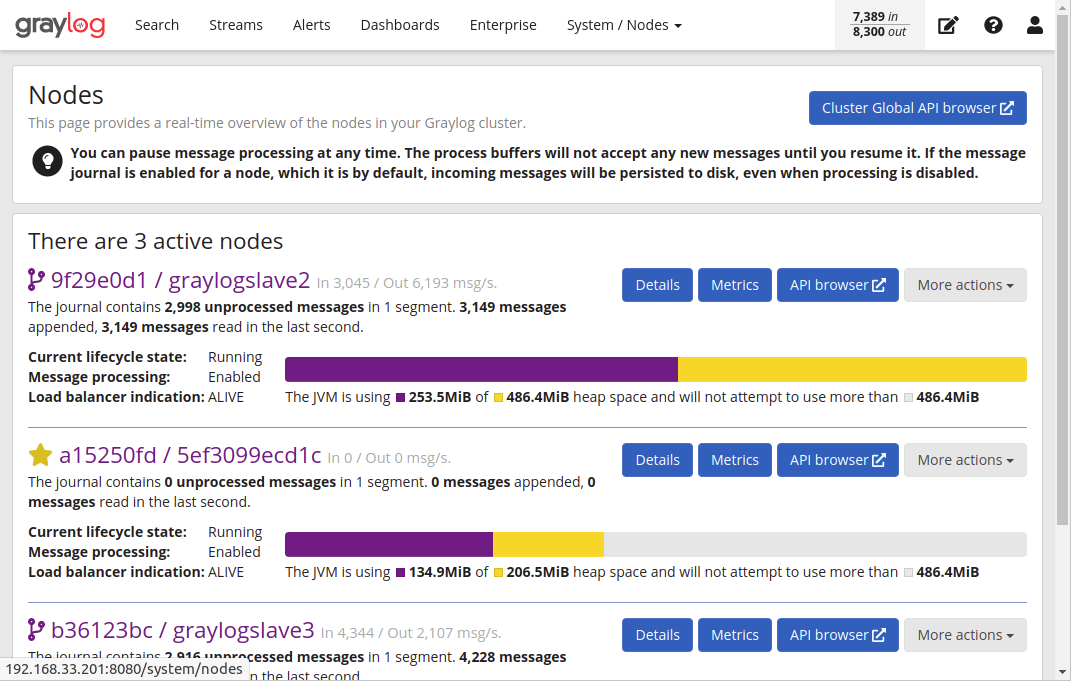Putting the Swarm to Work
Last weekend I built a docker swarm using an ansible role and deployed elasticsearch, mongodb and graylog into it, it worked but was useless because no way of ingesting data was defined. This week I added haproxy and rsyslog containers to de swarm in order to be able to ingest data. Docker swarm allows exposing new ports on containers dinamically, but as listening ports on graylog are defined by users at application level, they aren’t exposed without the intervention of an administrator.
Deploying HAProxy
I’ve deployed HAProxy in front of several graylog nodes many times, including deploying it using docker-compose, but for a swarm, I looked for more information and found a detailed blog page from HAProxy called HAProxy on Docker Swarm: Load Balancing and DNS Service Discovery. It served me as a guide, not only for deploying HAProxy, but for gaining a better understanding of swarm’s networking model, because that blog entry delved into it, comparing the three modes HAProxy can be deployed.
The first step was to create a HAProxy configuration file based on the blog suggestions and my personal experience.
global
log fd@2 local2
chroot /var/lib/haproxy
pidfile /var/run/haproxy.pid
maxconn 4000
user haproxy
group haproxy
stats socket /var/lib/haproxy/stats expose-fd listeners
master-worker
resolvers docker
nameserver dns1 127.0.0.11:53
resolve_retries 3
timeout resolve 1s
timeout retry 1s
hold other 10s
hold refused 10s
hold nx 10s
hold timeout 10s
hold valid 10s
hold obsolete 10s
defaults
timeout connect 10s
timeout client 30s
timeout server 30s
log global
mode http
option httplog
frontend graylog_ui
bind *:9000
use_backend stat if { path -i /my-stats }
default_backend graylog_ui
backend graylog_ui
balance roundrobin
option httpchk GET /api/system/lbstatus
http-request set-header X-Forwarded-For %[src]
http-request set-header X-Graylog-Server-URL "http://%[req.hdr(Host)]/"
server graylogmaster graylogmaster:9000 check resolvers docker init-addr libc,none port 9000
server graylogslave3 graylogslave3:9000 check resolvers docker init-addr libc,none port 9000 backup
server graylogslave2 graylogslave2:9000 check resolvers docker init-addr libc,none port 9000 backup
listen graylog
mode tcp
bind *:12200-12300
balance roundrobin
option tcplog
option log-health-checks
option logasap
option httpchk GET /api/system/lbstatus
server graylogslave2 graylogslave2 check port 9000 resolvers docker init-addr libc,none
server graylogslave3 graylogslave3 check port 9000 resolvers docker init-addr libc,none
backend stat
stats enable
stats uri /my-stats
stats refresh 15s
stats show-legends
stats show-node
The blog page suggested copying the same file to all worker nodes into de same route and bindmount it into the container. As it was not supposed to be changed during service operation, and it was small I wanted to give the swarm’s configuration feature a try, it’s well explained at Docker Swarm’s doc Store configuration data using Docker Configs.
The corresponding service definition was:
haproxy:
image: haproxytech/haproxy-alpine:2.4
ports:
- published: 80
target: 9000
protocol: tcp
mode: host
- published: 8080
target: 9000
protocol: tcp
mode: host
networks:
- graylog
configs:
- source: haproxy
target: /usr/local/etc/haproxy/haproxy.cfg
mode: 0444
volumes:
- haproxy-socket:/var/run/haproxy/:rw
dns: 127.0.0.11
deploy:
mode: global
resources:
limits:
memory: 512M
cpus: "1"
Deploying rsyslog
The next step was deploying rsyslog, as the official rsyslog docker release in docker hub was 3 years old, I looked for a more recent one, and I found jbenninghoff/rsyslog-forwarder amongst other images, but at least he spent some time writing a readme for docker hub. I followed the same strategy and created a configuration for rsyslog.conf
$MaxMessageSize 64k
module(load="imudp")
input(type="imudp" port="514")
module(load="imtcp")
input(type="imtcp" port="514")
$ActionForwardDefaultTemplateName RSYSLOG_SyslogProtocol23Format
$ActionSendTCPRebindInterval 3000
*.* @@haproxy:12201
As configs are limited in size and this was a proof of concept, I removed all comments and all unused directives, and, as this was meant to run inside a container, I also removed the socket listener for local messages.
I added the ActionSendTCPRebindInterval to make sure it balances between nodes, but that was a best scenario assumption because I had no means of knowing to which haproxy instance are the messages going, so I could get unwanted East-West traffic.
The corresponding service on my compose file was:
rsyslog:
image: jbenninghoff/rsyslog-forwarder
ports:
- published: 514
target: 514
protocol: tcp
mode: host
- published: 514
target: 514
protocol: udp
mode: host
networks:
- graylog
configs:
- source: rsyslog
target: /etc/rsyslog.conf
mode: 0444
dns: 127.0.0.11
deploy:
mode: global
resources:
limits:
memory: 512M
cpus: "1"
Feeding the beast
Once everything was in place it was time to put some records into graylog. I used a nxlog container on my host machine reading a 2M lines text file. The first attempt failed at the very first second, because there wasn’t space available for elasticsearch indices and it hit the watermark almost instantaneously.
Once the storage on the data nodes was extended, I succeeded to ingest all the messages at an acceptable rate of about 8K messages per second.

But they weren’t shown at the search interface, I searched directly into the graylog_0 index using cerebro and they were there, so I need to do some troubleshooting.
Troubleshooting
Storing messages in a unretrievable storage may be considered a safe practice, but useless, so next time I’ll focus on why aren’t they being shown.